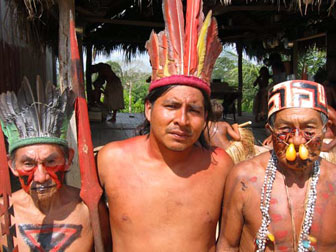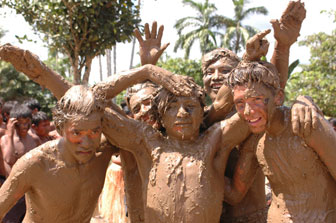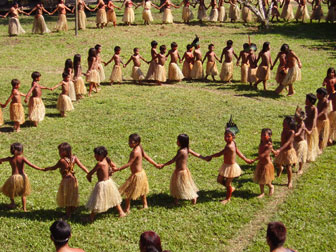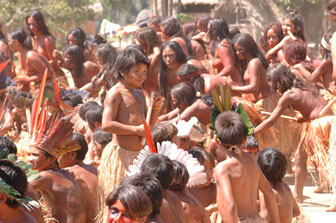Intellectual property rights reach indigenous communities in the Amazon
Intellectual property rights reach indigenous communities in the Amazon
By Carolina Bruun, special to mongabay.com
March 21, 2007
In an era where bio-tech companies and their patents grow twice as fast as the world economy, indigenous communities in Brazil start to think about patenting their cultural heritage to be protected from misappropriation
They still live in the middle of the Amazon forest and their culture has been little westernized. Their bathrooms are the rivers, their supermarkets are everything the forest has to offer and their TV is an hallucinogenic tea made from a jungle vine. But the world of patents became part of indigenous Amazonians’ universe well before these types of development.
“The whites created all these names like patent, intellectual property and biodiversity. It is very hard for us to understand them all, but we had to get used to them even though they have never brought any concrete benefit to us”, says Darcy Marubo, one of the leaders of the Coordination of Indigenous Organizations in the Brazilian Amazon (Coaib).
The first time Chief Darcy’s organisation got involved with the patenting world was in 1996. Coiab discovered that ayahuasca, the most sacred plant for indigenous peoples of the Amazon, had been patented by Loren Miller, an American scientist who visited the region. Mr Miller patent filing in the United States Patents and Trademark Office (USPTO) claimed he had found a new kind of ayahuasca (Banisteriopsis caapi) because the colour of the vine’s flowers was “different”.
The vine ayahuasca contains the hallucinogenic dimethyltriptamin (DMT). It is transformed into a tea and used by the Amazonian indigenous in religious ceremonies to diagnose, treat and cure diseases, as well as to meet spirits and foresee the future. With the argument of the plant’s sacredness and the fact that they had known it for centuries, the indigenous convinced the US patent office that the patent should never have been granted in 1999. But in 2001, the office changed its view due to a recall from Mr Miller. Despite protests, the patent was valid until 2003, when its expiry date was due.

Photo courtesy of the Yawanawa. |
“The Ayahuasca case shows the total disrespect of the whites’ world towards our beliefs and culture”, says Chief Darcy. Nowadays, Chief Darcy is one of the few indigenous leaders who follows closely the proposal of the Brazilian government to guarantee that patents mention any indigenous knowledge related to their novelty. Brazil also wants benefits from scientific or commercial developments derived from indigenous knowledge to be shared with them. However, it is still dubious that Brazil’s involvement in the subject is prompted only by an interest in the well-being of these communities.
The world’s market of drugs derived of plants is worth £16bn, according to the UN. Out of the 106 most used drugs in the world that are derived from medicinal plants, 79 were previously used by indigenous shamans, says the International Society of Ethnopharmacology, an international think-tank that gathers scientists interested in researching the knowledge of traditional communities. And these figures tend to rise, as companies have been leaving chemical combinations to explore natural resources.
Lately, the biotech industry has flourished as a supplier of research and patented knowledge to be transformed into products. The latest reports from the World Intellectual Property Organisation (WIPO), from 1990 to 2000, show that patents in general grew about 5 per cent annually, a rate that is similar to the world’s economy growth, while biotech annual patents rose by 15 per cent in the US and 10 per cent in Europe. But the producers of this knowledge are not widespread. According to WIPO, the use of patent systems remains “highly concentrated”: USA, Japan, Republic of Korea, China and the European patent office account for 74 per cent of all patents granted.
According to the Brazilian government, the country spends about £500,000 annually on royalties of patented chemical products and medicines that are based on the elements of its biodiversity, and possibly on its indigenous communities’ knowledge. Brazil is the world’s most bio-diverse country that holds around 20 per cent of the planet’s animals, plants and micro-organisms and one of the highest concentration of indigenous communities. However, it has never patented or fully developed a new drug based its bio or cultural heritage.
In 2001, Brazil approved a provisional national law that says that companies and researchers have to get previous consent from the government and communities to research and develop products based on the natural resources they use, as well as to share benefits with them from later developments. Internationally, Brazil is one of the 11 bio-mega-diverse developing countries who call the inclusion of the principles of previous consent and benefit-sharing of the UN Convention of Biological Diversity (CBD) on the World Trade Organisation (WTO) and its Trade Related Aspects of Property Rights (TRIPS).
“If our proposal comes true, patent filings will have to mention the origins of the resources and if there was any traditional knowledge involved. The government also wants to be a negotiator between communities and companies because their power of bargaining cannot be considered equal”, says Henrique Moraes, a Brazilian diplomat who participates in the WTO negotiations.
Brazil’s proposal is contested in the WTO by the US, that says that no amendment is needed on TRIPS because community rights can be guaranteed by private contracts between the indigenous and the institutions interested in working with their knowledge and resources. The EU has not submitted any formal document on the WTO, but via WIPO, it contests the point of Brazil’s proposal that asks patents to be cancelled when not in accordance with the principles of previous consent and benefit sharing.

Photo courtesy of the Yawanawa. |
Whilst Brazil fights abroad, experience shows that the country has not been able to guarantee its communities’ rights nationally. According to the UN Convention of the International Labour Organization (ILO), indigenous peoples have the right to participate directly in the decision making process of political debates that involve their rights, something that has not taken place in Brazil. “Brazil should take the rights of the indigenous peoples as seriously as it takes the rules of the WTO, but it doesn’t. Our participation in government meetings is very marginal and embarrassing, we can hardly speak and we cannot vote. It is revolting to see people working on the essence of our own culture when they are not interested in listening to the ones who have more to contribute”, says Fernanda Kaigang, an indigenous lawyer from the Brazilian Indigenous Institute for Intellectual Rights (Inbrapi).
As well as not including the indigenous directly in the process, Brazil has not been able to make its law work nationally. “The law is a big failure. It says good things, but it doesn’t work in reality. It was created by our politicians but they didn’t listen to us”, says Chief Darcy.
An example of Brazil’s failure to follow nationally the rules it wants to be implemented abroad are the Ashaninkas, an indigenous community based in the Amazon on the border of Brazil and Peru. In 1992, the Ashaninkas started a process to reinforce their culture and autonomy that had been damaged by contact with loggers in the region. “We were looking for alternative ways to make money to buy simple things like tools that we usually get from the market and we knew we didn’t have only wood to offer”, says Francisco Píyãko, one of the tribe’s young leaders.
The Ashaninkas invited a young Brazilian scientist, Fabio Dias, to live in their tribe and help them in their search, tells Chief Francisco. The researcher lived in the tribe for three years and married an anthropologist who had also lived there and was the ex-wife of the tribe’s chief. “His role was defined by an ‘oral contract’ in which any results should be given to the tribe. But the contract was broken”, says Chief Francisco.
Nowadays, Mr Dias owns a company that gets £7,500 a month with the sale of soaps made of the oil of a nut, the murmuru. According to the company’s spokesperson most of the revenue comes from the Brazilian market, but the soaps are already being exported to the US and France. The soaps carry a fair-trade label, but they do not mention that the same oil they use to make the soaps is used by the Ashaninkas as skin moisturiser for children. The scientist denies any link with the traditional knowledge of the indigenous. In 2003, he filled a patent as the inventor of the murmuru soap in the Brazilian patent office. The patent did not mention where the nuts were taken from and neither that he had lived in a community that uses them as a skin moisturizer. The Ashaninkas went to court and the patent filing was cancelled, but they are still waiting for any benefits.
Brazil’s most known indigenous rights campaign group – the Socio-Environmental Institute (ISA) – made a survey under the guidelines of the Centre for Economic Aspects of the Genomics of the University of Lancaster to analyse the effectiveness of the Brazilian patenting system. The survey indicated that like the Ashaninkas, many other tribes could have had their knowledge ‘stolen’ by the Brazilian patenting system. The results showed that less than 2 per cent of the patents filed in Brazil that accessed the country’s bio-genetic resources mentioned where the resources were found and in which community they were researched.

Photo courtesy of the Yawanawa. |
“It is true that we still have to implement nationally what is being proposed abroad. But we are already working on it”, says Guilherme Amorim, a lawyer from the Brazilian Environment ministry. But Mr Moraes, the Brazilian diplomat, mentions another case of indigenous knowledge’s misappropriation to reinforce the need of international cooperation to make things work in Brazil. The case mentioned by Mr Moraes is of a poison of an Amazonian tree frog, phyllomedusa bicolour, used by more than 10 indigenous communities in the State of Acre, one of the most remote corners of the Amazon forest.
After getting reports from journalists and anthropologists who visited the region and watched the indigenous burning their skin and rubbing the frog’s poison to go hunting and to prevent diseases, scientists in Europe and in the US have filled more than 20 patents on the frog’s poison substances. And in this case, the indigenous proved to be naturally formed scientists. The ‘go-hunting’ effect can be explained by demorphine, a pain killer that is 33 per cent stronger than morphine. And the disease prevention mentioned by indigenous became patents on deltorphine, an anti-bacterial substance that can be used to combat malaria and Aids.
Three of the Brazilian tribes that use the frog’s poison have declared their interest to be benefiting from these scientific developments, but the Brazilian government is still trying to find out if these patents have already been transformed into medicines and profits. “It is difficult to follow the link between a patent and a product. It is hard to find out how much the substances are present in a final product and how important they are in the whole composition. The results from our research are too preliminary to say if the poison has become a product”, says Mr Moraes.
While the Brazilian Foreign ministry works on its research abroad, the Environment ministry has tried to find companies to work with the indigenous to develop a medicine with them. “We want to work in partnership with a company to isolate one of the molecules from the frog’s poison and develop a medicine that is going to be patented in our name.”, says Fernando Katukina, the Chief of the Katukina’s tribe, one of the three tribes that has worked with the Environment ministry.

Photo courtesy of the Yawanawa. |
But Chief Fernando’s expectations face a logic that is different from the communal way of thinking of his tribe. “We have prepared the indigenous to negotiate with a company, but the company doesn’t even want its name to be published. We wanted to create a pioneer project, but the provisional law we have is too unstable to support a risky investment like this. The company says it is very risky for its image if the project fails and doesn’t meet the indigenous’ expectations”, says Bruno Filizola, the director of the Brazilian Project for Bio-prospecting (Probem).
Another tribe that got involved with the frog’s project could not forget about the patenting world when it launched a fashion company that uses their body paintings on the clothes they sell. “We have tried to register these paintings on behalf of our people, but we couldn’t. The Brazilian patent office said it was a communal knowledge, and not an individual one. So, we had to register them on behalf of only one of us and this caused conflicts in our community. For us, nothing is private, everything belongs to all of us”, says Joaquim Yawanawá, a young leader of the Yawanawá people.
The issue exposed by Chief Joaquim has also been criticized by non-Indigenous. “The Brazilian government is proposing contracts and private intellectual property. It ignores the indigenous collective understanding of knowledge. If the sharing of benefits comes true, it will be a financial payment that someone will use to privatize the indigenous knowledge on its behalf”, says Fernando Mathias, a lawyer from ISA, the Brazilian NGO that has done the study on the country’s patenting system.
At the same time that Brazil fights abroad and nationally, the indigenous that already have been in touch with the patenting world seem not to have another choice but to get involved. “It might not be the best way to do it, but for us to survive and guarantee our rights, we must dance to the song that the others play”, says Chief Joaquim.
Carolina Bruun
Carolina Bruun is London-based Brazilian working on a masters degree in International Journalism at City University in the UK. She spent two months in Acre, Brazil developing this and other articles.













